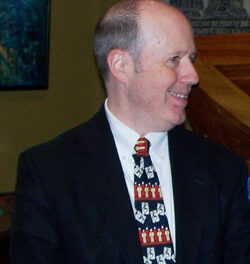The North Carolina Symphony‘s winter season continues with a sparkling performance from James Ehnes, the celebrated Grammy-winning violinist whose influence and credits have been spreading from his home in Canada since he was a teenager. The Shostakovich Violin Concerto in A minor, Op. 99, was bookended by two pieces, also of Russian origin, allowing the audience to draw interesting comparisons among the three styles of music. Director Grant Llewellyn kicked off the weekend of Prokofiev, Shostakovich, and Tchaikovsky in Chapel Hill’s Memorial Hall.
Composed in 1919 (30 years before Shostakovich’s Concerto and 30 after Tchaikovsky’s Fifth Symphony), Prokofiev’s Overture on Hebrew Themes, Op. 34b, plays on the dichotomy of an upbeat texture against minor mode, drawing from the direct inspiration of Jewish folk music. Snaking melodies are traded among the woodwinds against a restrained string pizzicato, now and then releasing tension by accelerating the tempo before drawing back again.
This same dichotomy, or, as Shostakovich described, “laughter through tears,” was explored further in the orchestra’s performance of the concerto with Ehnes. Drawn straight from the origins of Klezmer melodies, the first movement, Nocturne, opens with a weeping melody in solo violin played over haunting low strings. Over the course of one long, organic-sounding phrase that never takes the bow off the string, other instruments creep in. The following movements, especially the playful but fiery Scherzo, elevated the intricate rhythmic interaction between Ehnes and orchestra. Rapid phrases exchanged between Ehnes alone and the entire NC Symphony in homophony made the energy of this movement boil over. Then the funeral march-esque theme of the Passacaglia movement was developed by Ehnes in a cadenza connecting the third and fourth movements. Perhaps the highlight of the concert, Ehnes’s strength of playing incredibly soft while still maintaining resonance and expression was spellbinding. When the orchestra entered again, a veritable storm of notes and complicated rhythms took over. A chorus of “Bravos” erupted after the final chords were played.
Tchaikovsky’s confident and heroic Symphony No. 5 in E minor, although not directly inspired by Jewish music. like the previous pieces, maintains glimpses of playfulness as well as lyrical melodies throughout. In the second Andante movement, a lonesome, poignant melody from a solo horn is laid over romantic chords in the strings, leading to intensely passionate moments that are suddenly interrupted by the ominous theme of the first movement. The third movement, a waltz, overlays a typical waltz texture with meter changes and other embellishments, a series of changes that Llewellyn navigated gracefully. The fourth movement covered a lot of thematic ground from the first three, with surprising transitions. A dramatic drum roll and large crescendo (not the first time, but the second) brought the symphony to a close.
This same program is repeated in its entirety in Raleigh Friday and Saturday with a slightly different program in Wilmington on Sunday. See our sidebar for details.











